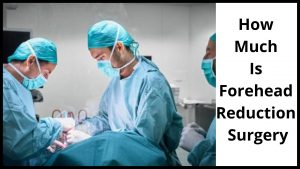
Forehead reduction, also called forehead lifting surgery, entails removing excess skin from the forehead and moving the forehead forward.
The incision used to perform this operation is usually invisible when the skin heals and is placed behind the hairline.
This subtle shifting of just an inch or two upwards can often create a dramatic difference in the appearance of the face.
How Much Is Forehead Reduction Surgery?
If you want to know how much is forehead reduction surgery going to cost you, here is it and what to know.
Forehead reduction surgery cost ranges from $4,500 and $11,000 for the procedure to be performed.
The cost of forehead reduction surgery will depend on the number of procedures that are required and the extent of the surgical procedure required.
There are typically two procedures that can be performed during the treatment.
One will require the use of scalpels, while the other will involve using a small instrument that is pushed under the skin.
After the instruments are inserted into the skin, they will be brought out of position through a tiny cut made by the surgeon.
This cut is typically made at about one centimeter above the surface of the skin.
Once you have received all of your paperwork from your cosmetic surgeon and the cost for the procedure has been set, it is time to speak with him.
During your consultation period, he should explain the reasons for your procedure and what he hopes to achieve by having you undergo it.
You should be provided with a detailed list of all the things that you need to do prior to and after your surgery.
It is important that your surgeon be very honest with you about the outcome so that you are aware of what you are going to be facing once it is all said and done.
When you speak with your surgeon during your consultation period, you should ask him a series of questions about the procedures and what he hopes to achieve.
If you are considering forehead reduction surgery on an outpatient basis, you should also ask for his opinion on any necessary preparations that you will need before your procedure takes place.
Please provide details about any medications that you may be on such as aspirin or any other anti-inflammatory medication.
If you are suffering from allergies, you should also let your consultant know about them.
In fact, if you are a smoker, you should inform your consultant about this so that he can avoid having to administer any medication to you during the operation.
The forehead reduction surgery procedure generally takes about three to four hours.
This procedure works effectively for most people.
But if you are allergic to any of the anesthesia used in the procedure, you may need to take an over-the-counter antiseptic just before your procedure.
If you smoke, please notify your cosmetic surgeon about this, as well as any other health problems that you may be experiencing.
It is important that you keep yourself calm and do not panic as you approach the surgical procedure.
Most patients who have undergone forehead reduction surgery have been thrilled with their results.
And have said that they would do it again if they had the opportunity.
While the actual surgery itself can be quite scary, you should not be worried about the anesthesia as long as you follow your cosmetic surgeon’s pre-operative instructions.
Your surgical doctor will tell you exactly how much to eat or drink, how long you should be awake.
And how soon you should expect to be able to resume normal activities.
Some patients experience excessive swelling after forehead reduction surgery, but this usually settles within a day or two and is rarely serious.
Other patients may experience some bruising or swelling of the scalp or face, which will most likely be temporary.
But more severe cases of bruising or swelling may need additional treatment by a skin specialist.
The skin specialist may inject colloid into the scalp to help reduce the appearance of swelling.
Before you schedule a consultation with a surgeon to discuss the possibility of forehead reduction surgery, you should research the plastic surgeons in your area so you can find one with experience and a good reputation.
You can look online to see if any cosmetic surgeons have a website where you can learn more about them and what they offer.
During your consultation, the surgeon will ask you many questions to help determine if you are a good candidate for this procedure.
You should also inquire about any medications you are taking, such as birth control pills or asthma inhalers, since these may affect your surgical procedure.
And you will also want to find out if you have any pre-existing conditions or diseases that could affect your procedure.
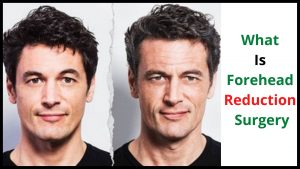
What Is Forehead Reduction Surgery?
Forehead reduction, sometimes called forehead lifting, is a common cosmetic plastic surgery procedure that reduces the size of your forehead by moving it about one to two inches upwards.
It is a means of reducing the apparent appearance of a high forehead by eliminating a larger forehead line surgically.
It has nothing to do with balding, thinning hair, or even any other recognizable type of pattern balding.
The actual procedure is actually performed on patients who are mildly hypertrophic and who have a relatively large forehead.
This will also serve to enhance the sharpness of the eyebrows.
A forehead reduction surgery should only be considered on patients who are absolutely healthy, and who have issues with their forehead.
Forehead reduction surgery works well for treating people whose brows are too high because it eliminates the deep creases that can only be surgically repaired by making incisions into the scalp.
In fact, some surgeons use a “lift and trap” technique in which the incisions are made below the hairline itself.
The result is that the skin is lifted slightly higher and in turn, the forehead is reduced in size.
A good forehead reduction can produce amazing results if it’s done properly.
If the plastic surgeon does an exceptional job, then you should be able to reduce your forehead lines up to an almost undetectable level.
Furthermore, you will feel less self-conscious about your appearance since your new profile will look more natural.
Of course, this type of cosmetic surgery does take time to heal and recovery is important.
Many people assume that a forehead reduction can be done immediately, but this is not always the case.
In fact, the recovery time for this surgery is quite extensive, ranging from three months to a year.
Your plastic surgeon will most likely combine forehead reduction surgery with a facial hair transplant to further thicken the skin and hide the surgical wound.
If you have never had plastic surgery before or are very concerned about the results, there are many preoperative and postoperative preparations to think about.
You should also consider what the results might be because you want to be satisfied with the outcome.
To help you decide if forehead reduction surgery is right for you, here are some of your options.
Procedures can be performed under local or general anesthesia.
Your surgeon will advise you on the best anesthesia to use based on your individual circumstances and the degree of discomfort.
In general, you’ll be given several hours of sleep before the procedure and advised to remain calm and rest until the anesthetic begins to wear off.
There are some people who experience mild to moderate sedation during forehead reduction surgery; others experience strong and continuous sedation.
Be sure to ask your surgeon if you are given any other sedative medications, and ask him or her to explain the medications in detail.
A forehead reduction surgery normally takes around 3-4 hours, including the time for recovery.
This surgery is more likely to be successful if done on an outpatient basis.
If you have a history of allergies to anesthesia, you should discuss this possibility with your surgeon, and work out a solution that allows you to safely have the procedure.
After your initial consultation, your plastic surgeon will discuss your case with you and do some basic diagnostic procedures.
During the lowering consultation, he or she will examine your skin and determine your best skin creasing target.
Also, during the lowering consultation, the doctor will also examine your hairline and cheek areas, and determine how much work needs to be done in these areas.
The goal of the lowering consultation is to find the most appropriate surgery solution for your particular situation and desired results.
There are many variables that will affect your forehead reduction surgery outcome, including your skin quality, the amount of fat to be removed, and whether you’re having the procedure done under general or local anesthesia.
It’s also important to realize that a forehead reduction doesn’t always produce the desired result.
If your surgeon isn’t very experienced or skilled, then the results may not be as impressive as you hoped.
Also, some types of cosmetic procedures are more complex and require additional surgery after they’re completed.
If you have any questions or concerns about your recovery, you should discuss them with your doctor before making any decisions or arrangements.

What Age Can You Get A Forehead Reduction? – Ideal Candidates for Forehead Reduction Surgery.
Age is indeed a very important factor when it comes to getting the right results from forehead reduction surgery.
It is a sad fact, but more people are able to get plastic surgery even at a very young age.
Many people will never be able to expect to get such surgery until they are in their mid to late 20s and above.
Usually, any age above 16years is an ideal age.
However, there are some people who will be able to have it done at a very young age.
If you are one of these ideal candidates, you will want to know what your options are.
Another group of candidates who are ideal candidates for a forehead reduction surgery is those who have a thick head with hair.
Also patient with a large forehead and high hairline.
A patient that wishes to lower their hairline by about 1cm is an ideal person.
Women with little or less frequent hair fallout are also good candidates.
When considering who is an ideal candidate for a forehead reduction surgery, it is important to remember that many candidates are extremely fit, which makes them a good candidates for the procedure.
However, there are also some unhealthy candidates, just as there are healthy individuals who may be ideal candidates for surgery.
For the sake of clarity, the term ‘unfit’ refers to those with severely droopy eyelids and those who suffer from extreme folds over their nose.
These candidates may not be good candidates for surgery because their anatomy does not lend itself to the quick recovery of swelling and excess fat.
It may be years before these candidates are able to undergo cosmetic surgery – even if they do receive an adequate amount of anesthesia.
Because many candidates fall into the category of unhealthy candidates, when considering who is an ideal candidate for a forehead reduction surgery, it is important to carefully screen each potential candidate.
Because this operation entails making an incision into the fatty tissue.
It should be noted that who is an ideal candidate for a forehead reduction surgery does not solely rest on the physical characteristics of a patient.
Instead, it is important to consider one’s personal comfort and satisfaction with the overall appearance of one’s skin.
One of the most effective ways to determine if you are a suitable candidate for who is an ideal candidate for forehead reduction surgery is to closely examine your skin.
If there are excessive folds or sagging areas
There are several things that can happen if you have had plastic surgery at an early age.
Your skin and hair will be smoother and less curly, which is usually the case when you are younger.
And your forehead may appear a little more defined as well.
There are a few other benefits that you will notice, but these are the biggest things that you can expect to happen.
You should go talk to a doctor right away to determine if you are a good candidate.
Your skin and hair must be relatively healthy in order for this to be a possibility.
If you do not have good skin and hair already, you should work on both of these areas by using the products that you use to maintain your appearance.
Be sure that you are not using products that could be damaging to your skin or hair.
If you use a cream that is too strong, you might end up making your problem worse.
When people are told that they can safely get a forehead reduction, they often wonder if this means they are going to get less skin.
This is not true because there are different types of filler that are used for skin-reduction purposes.
Some are made to help with getting rid of small amounts of extra skin, while others are made to help with eliminating large amounts of skin.
You should talk to a dermatologist to see what type of product you should use based on your skin.
Patients should also understand that in order to be ideal candidates for the surgery they must meet the surgeon’s ideal candidates criteria.
In order to be considered an ideal candidate plastic surgeons will consider both age and overall health.
Potential candidates will also need to be committed to a long period of follow-up care.
If you are younger than twenty years old, you might consider getting surgery to improve your face.
This is an option that many people look at, but it is one that should be carefully considered.
Surgery can be a great thing, especially for people who suffer from skin problems or simply want to change the way their face looks overall.
But it is important to consider all of your options and talk to your doctor about any other procedures that may be necessary as you age.
While age is one of the primary factors that determine the amount of skin you will have to deal with, it is not the only determining factor.
If you are in doubt about anything regarding a forehead reduction, you should definitely discuss it with a doctor today.
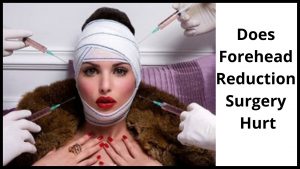
Does Forehead Reduction Surgery Hurt?
A lot of patients who’ve had this type of surgery say that it hurts a bit, but most medical professionals concur that it’s not as bad as some other procedures might be.
In fact, many patients say that the only time that they feel discomfort is when they’re asleep.
This is because when air is forced up into the nasal passages during the procedure, there’s some swelling in the soft tissue that’s exposed during the procedure.
(Afterward, the swelling goes down as the body restores itself to its normal shape.)
And while some patients report that they’re itching or having an unpleasant feeling before they have to wake up the next morning, others say that they’re fine the morning after the procedure.
As far as how much forehead reduction surgery hurts, it depends on how large your forehead is and how deeply the incisions have to be made.
If your forehead is very large, then you can expect to go through several incisions, which can cause your face to look quite bruised.
Those who have very small foreheads can often get away with only one incision, although your face will probably be a bit swollen for a day or two afterward.
(So, you should expect to experience a moderate swelling for three to five days and moderate to high blood pressure as well.)
“Does forehead reduction surgery hurt?” It is important to know what happens during the procedure.
During forehead reduction surgery, a small incision is made in the hairline.
The surgeon then removes excess tissue until the desired result is achieved.
Some additional tissue may be removed, while some may not be affected.
The forehead typically slopes to one’s high hairlines, making forehead reduction surgery helpful in eliminating the droopy high hairlines and allowing one to look fresh and sharp.
High hairlines can also cause neck and face lines to widen.
By removing the high-hanging hairline, a sloping forehead can be created.
The sloping forehead will restore a youthful appearance, without wrinkles or sagging.
Some patients experience some discomfort after the procedure.
A large forehead, along with high forehead-line and drooping eyelids, can lead to neck and face problems, such as: neck and face pain, headaches, eye fatigue, and vision problems.
The procedure can also lead to forehead thinning or hair loss.
When a patient undergoes forehead reduction, the hairline is lowered and the forehead is reshaped.
The result is a smaller but wider-looking face.
A high forehead and large forehead-line are common among people who are severely overweight.
When these features are brought into focus, people can gain a more slender appearance and feel more confident about their image.

How Long Does Forehead Reduction Take To Heal?
Many people with this condition are surprised to find out that it usually takes three to six months of healing and rehabilitation before they can actually see an improvement in their appearance.
It is normal to have some swelling after having a forehead fat removal procedure done.
And it is important not to push this swelling down or to keep it from coming back, as this can cause serious scarring later on.
During the first couple of weeks after your surgery, you may feel some tightening in the skin near your forehead.
This is perfectly natural and will go away as the healing process continues.
However, if you notice that it gets worse or lasts longer than expected, then you should seek consultation with a doctor.
Your doctor will be able to run scans and tests to determine why you are having this problem.
You may just have a slightly weaker muscle in your forehead or you may be suffering from an infection.
If so, the healing time will also be a lot shorter.
After healing has been done, the final few weeks of recovery will include a period of light restriction for the area.
This means no playing or any type of strenuous activity.
The light restriction could last anywhere from a few weeks to a month depending on how your skin heals.
Some patients notice that they are able to play a sport or go to the beach for the first time in several months.
Recovery time depends on the severity of the procedure you had done and your skin type.
During this period, you will have to follow any and all recommendations your surgeon gives you.
These may include using special skincare products that are designed to promote the healing process.
In addition, the skin around your eyes will have to be cleaned more carefully to prevent any infection.
The entire procedure may seem quite invasive at first but this healing process usually only takes a few weeks.
Your forehead will look normal and beautiful once the healing process has finished.
There are certain factors that can contribute to how fast you heal but there is no ceiling on how fast you can expect it to happen.
Your forehead may heal faster than others because your skin is thinner on your forehead.
Some people may need more than one procedure to get the results they want.
And some people heal more quickly than others due to emotional stress and the trauma their procedure caused.
It’s natural to have an aversion to scars and to the operation.
However, if you are willing to put in the required time and effort, you will reap the benefits of a forehead lift.
Once you have healed from a forehead reduction procedure, you should avoid sun exposure.
If you do get to go outside, wear sunglasses or invest in a hat to protect your skin during the day.
You should not try to increase your sun exposure because this can slow down the healing process or cause unnecessary damage to your skin.

Are You Awake During Forehead Reduction Surgery?
Yes, local anesthesia does allow a patient to be conscious and alert during the
During your procedure, local anesthesia will be applied to your eyes.
Local anesthesia helps to numb the area around the eye, but it also numbs the muscles and the sinuses around the eye.
This means that you may not feel anything when the anesthetic agent is applied to your eyes.
However, it may cause some slight pain or discomfort for a few hours after the local anesthesia is taken off of you.
That’s how the healing process does.
If you are wondering if you are awake during forehead reduction surgery, then you should be aware that you may be feeling lightheaded or experiencing a mild headache.
This is common for all patients, so you shouldn’t feel worried about it.
You may experience nausea or a vomiting episode, but these are fairly rare.
After forehead reduction surgery, you may be asked to go home with a list of instructions for taking medications and other questions.
These instructions will be given by your plastic surgeon or doctor.
Make sure that you follow them closely.
It should also be mentioned that you may experience some bruising or swelling after the procedure, which can make you feel sleepy and drowsy.
Fortunately, this is rare and temporary.
You should see that it goes away within a day or two, so don’t worry too much about it.
Once you have been discharged from the hospital, you will need to take a few days to heal before you can resume your normal activities.
Even though you might feel sleepy and drowsy the whole time, don’t get discouraged.
You should expect to return to your normal self within two weeks.
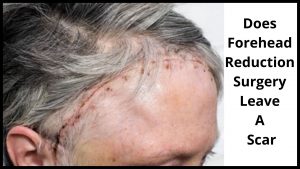
Does Forehead Reduction Surgery Leave A Scar?
Yes, a scar will be left on your hairline where an incision is sutured.
The reason for this is because forehead reduction procedures typically include stitching an incision into your forehead.
It can be as insignificant as just a tiny sliver of skin is cut away.
The scar tissue that grows from the incision is what will leave a visible scar on your hairline.
And the amount of scarring that you will experience will depend on the scar depth as well as the exact procedure used to create the forehead reduction.
A forehead reduction that involves stitching an incision into your skin can leave scarring in just a couple of areas.
The uppermost edge of your forehead may remain untouched while the sides and angles of the scar will each include creases.
This scarring is not very noticeable because it is so small.
However, some people do notice the scarring quite clearly.
The final scar will vary depending on how much skin has been removed, the thickness of the skin, and the surgical technique that was used.
A different kind of scar that can appear after a forehead reduction is one that extends down your hairline.
This type of scar will extend from just above your eyes down to just below your eyes.
And this type of scarring is harder to treat since the angle of the scar and the skin around it can cause it to wrinkle and fold.
In addition, the scar itself can become irritated and even cause your hair to be limp or weak.
And in extreme cases, this type of scarring can even become visible through your hairline.
The final scar that you can expect to see from a forehead reduction is one that is caused by your healing process.
It can appear as a thin line or as a raised area on your forehead or temple.
This raised area will be the last scar you will see before fully healing.
Your forehead may also cause your cheeks to look puffy or even enlarged because of the extra skin.
You may also notice that your forehead may feel slightly heavier than normal.
If you are wondering ” Does forehead reduction scar?” Then you should consider your options.
Surgical scar reduction is an effective way to get rid of the scarring, but it can also be dangerous if done incorrectly or if there are complications during the surgery.
For this reason, it is important that you find a surgeon who has been performing this treatment for years and asks plenty of questions to make sure that they are qualified to perform the procedure.
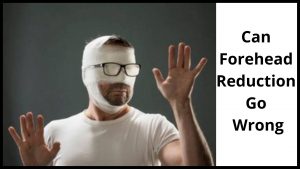
Can Forehead Reduction Go Wrong?
If you are considering forehead reduction to improve your appearance, the risks that you should be aware of are cosmetic-surgery complications, anesthesia risks, complications with the procedure itself, and long-term scarring.
As with any surgical procedure, it is important that you carefully consider all the risks before going ahead and having a procedure done.
There are many reasons why a patient may undergo forehead reduction.
You may want to give your face a more youthful appearance, reduce deep lines and wrinkles, or you may just want to aesthetically fit in with today’s image.
It is important to think about all of these before you go ahead and have a surgical procedure done.
This is because if you are not completely sure about the procedures and the risks that you will face, then it may not be in your best interest.
For this reason, you need to make sure that you have all of your facts before you go ahead and undergo forehead reduction.
Any type of surgical procedure carries some risks, but forehead reduction is one of few that has more risks associated with it than others.
Aesthetic surgery involves making incisions into the skin of the forehead, and then the tissues are moved around to correct the underlying problem that is causing the issue.
Unfortunately, there is often a lack of understanding as to the full implications of these kinds of procedures.
For example, when you have a surgical procedure like forehead reduction, you are essentially cutting out an area of your face that will help your overall appearance.
Therefore, when you are thinking about can forehead reduction goes wrong, you need to ask yourself whether the procedure will really change your appearance or whether it will simply hide the problem that you have.
Another thing that you need to consider is the scarring that you may encounter as a result of a can forehead reduction goes wrong.
You should know that cosmetic surgery is not without risk, and this is especially true in the world of plastic surgery.
You may end up with scarring that will last a lifetime, even if your surgery is performed properly.
If you are not willing to deal with this issue, then you may want to consider another way to get rid of your lines and wrinkles.
There are a number of different products on the market today that claim to be able to help you achieve the results that you want.
However, before you invest in these products, you may want to think about how likely they are to work and whether or not they are worth the cost.
Forehead reduction going wrong is an extremely common occurrence, and you should be prepared for what might happen once you decide to get this procedure done.
Not only will you be left with undesirable scarring, but you may also end up with headaches and other problems that make it hard to function properly.
This is why you need to understand all of the risks that are involved before you agree to have anything done, no matter how cheap or high quality the product claims to be.
It is important that you ask yourself some tough questions before you choose to have a procedure done, questions like, can forehead reduction go wrong?
If you are considering having this procedure done, then you need to be sure that you are ready to face all of the risks that are involved in having this done.
Remember, there are some great products available if you are ready to make this decision.

Conclusion:
Because there are so many different factors that go into determining the price tag of a forehead lift operation, the amount that you are asked to pay will ultimately depend on many different things.
The first thing that you should remember is that the more complex or more invasive the surgery that you have scheduled, the more that your doctor will charge you for the service.
Your doctor will use all kinds of factors to determine how much to charge you, including but not limited to your past medical history, the type of surgery that you will have performed, and other such information.
One thing that you may be interested in knowing as you seek out how much is forehead reduction surgery is how much is typically charged for different types of forehead lifts.
If you seek out an operation that will require extensive scarring, then you will likely pay a much higher price than if you sought out a simple surgery that does not require any significant amount of scarring.
The same can be said if you have a particularly severe case of acne scars that have caused you to need a more serious forehead lift.
While some procedures are far more expensive than others, they are also very rarely covered by any insurance, so you will need to factor that into the equation.
While you will certainly want to learn as much as possible about how much is forehead reduction surgery going to cost you, it is also vital that you make sure that you are getting your hands on a good deal.
Because you will be getting a very expensive operation, it is crucial that you find a surgeon that you can trust.
You should definitely ask for references and check them out thoroughly before choosing which surgeon you want to do your procedure with.
It is far too easy for people to try to take advantage of people who don’t have all of the information that they need, so always ask questions and double-check before making your decision.
Doing this will ensure that you get the most for your money and that you feel comfortable about the overall quality of the service that you receive.
